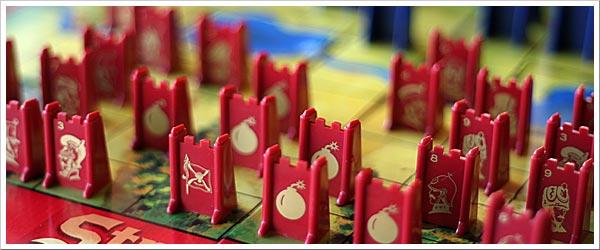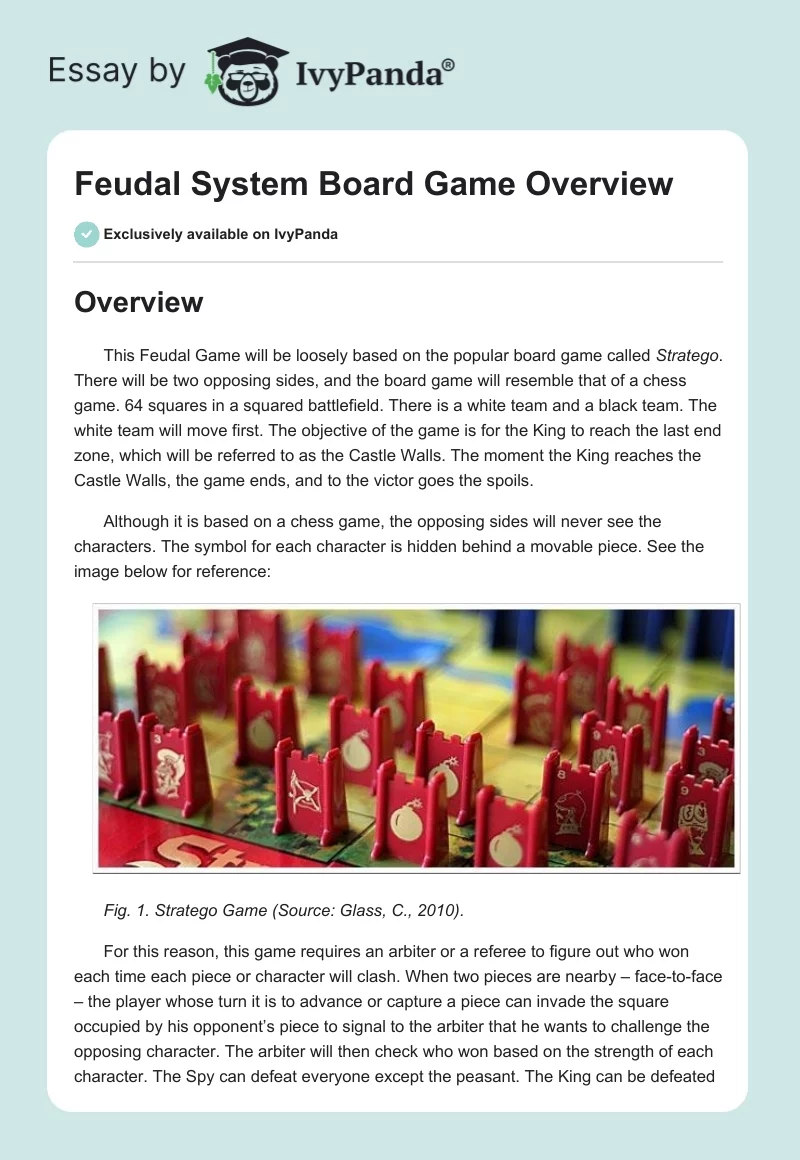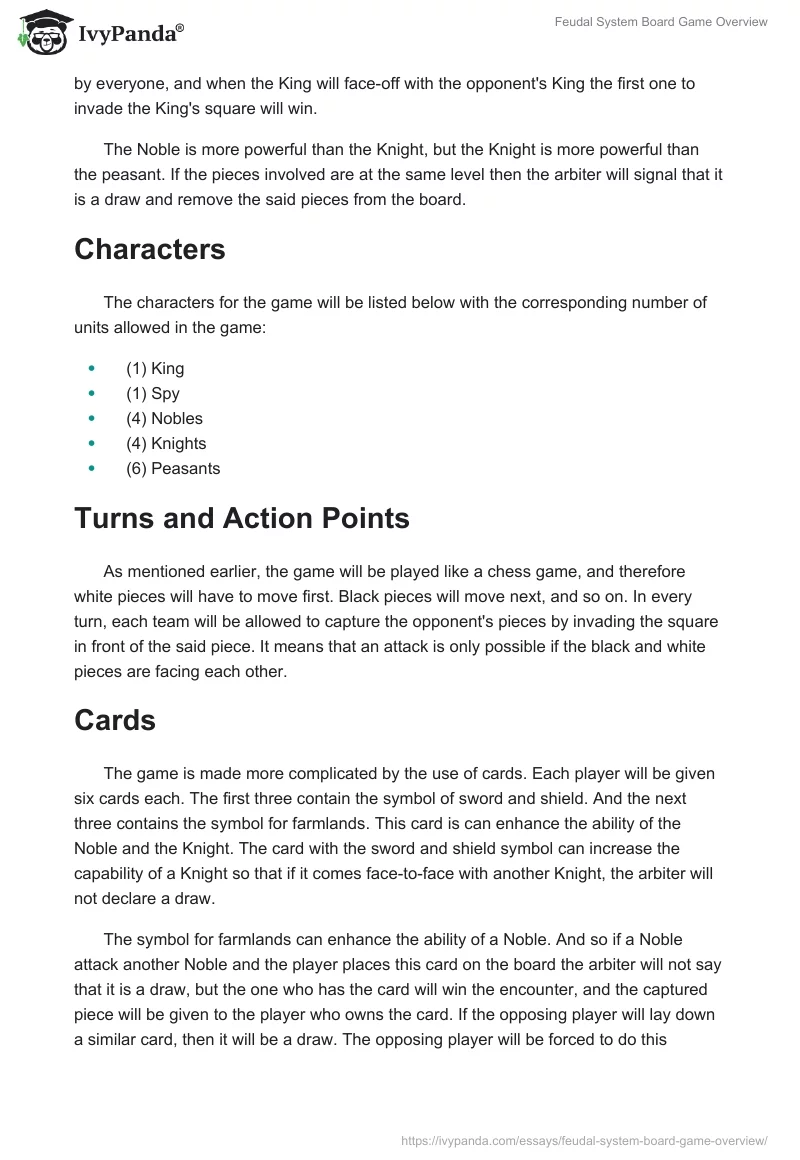Overview
This Feudal Game will be loosely based on the popular board game called Stratego. There will be two opposing sides, and the board game will resemble that of a chess game. 64 squares in a squared battlefield. There is a white team and a black team. The white team will move first. The objective of the game is for the King to reach the last end zone, which will be referred to as the Castle Walls. The moment the King reaches the Castle Walls, the game ends, and to the victor goes the spoils.
Although it is based on a chess game, the opposing sides will never see the characters. The symbol for each character is hidden behind a movable piece. See the image below for reference:

For this reason, this game requires an arbiter or a referee to figure out who won each time each piece or character will clash. When two pieces are nearby – face-to-face – the player whose turn it is to advance or capture a piece can invade the square occupied by his opponent’s piece to signal to the arbiter that he wants to challenge the opposing character. The arbiter will then check who won based on the strength of each character. The Spy can defeat everyone except the peasant. The King can be defeated by everyone, and when the King will face-off with the opponent’s King the first one to invade the King’s square will win.
The Noble is more powerful than the Knight, but the Knight is more powerful than the peasant. If the pieces involved are at the same level then the arbiter will signal that it is a draw and remove the said pieces from the board.
Characters
The characters for the game will be listed below with the corresponding number of units allowed in the game:
- (1) King.
- (1) Spy.
- (4) Nobles.
- (4) Knights.
- (6) Peasants.
Turns and Action Points
As mentioned earlier, the game will be played like a chess game, and therefore white pieces will have to move first. Black pieces will move next, and so on. In every turn, each team will be allowed to capture the opponent’s pieces by invading the square in front of the said piece. It means that an attack is only possible if the black and white pieces are facing each other.
Cards
The game is made more complicated by the use of cards. Each player will be given six cards each. The first three contain the symbol of sword and shield. And the next three contains the symbol for farmlands. This card is can enhance the ability of the Noble and the Knight. The card with the sword and shield symbol can increase the capability of a Knight so that if it comes face-to-face with another Knight, the arbiter will not declare a draw.
The symbol for farmlands can enhance the ability of a Noble. And so if a Noble attack another Noble and the player places this card on the board the arbiter will not say that it is a draw, but the one who has the card will win the encounter, and the captured piece will be given to the player who owns the card. If the opposing player will lay down a similar card, then it will be a draw. The opposing player will be forced to do this because he will realize quickly that his or her opponent has guessed the character behind the said piece.
If the opposing player makes a mistake, say, for instance, he made the mistake of assuming that it is knight versus knight, and so places the card with the sword and shield, but the real character behind the piece is a Noble, then he is defeated and his card taken away by the arbiter or referee. But he gains the knowledge that this particular piece is a Noble and not a Knight. The arbiter will collect every card that was laid down on the table. Each card can only be played once.
Since the players will never know if the attack was made by a character of equal force and therefore they will never know the right time to place the appropriate card on the table. Since this game is like a complicated memory game, they will have to make a guess using the captured pieces and the way the opposing player moves his pieces around the board.
Goal and Strategy
The ultimate goal is for the King to reach the Castle Walls. But the King is vulnerable to everyone, including the opposing King who can easily capture or defeat it if the opposing player will guess correctly that the piece making a beeline towards the Castle Wall is indeed the opponent’s most powerful piece. So each player must design a strategy that will protect the King but, at the same time, move it closer and closer to the Castle Walls.
A player can bluff the opposing player by making it appear as if a piece is moving quickly to the Castle Walls. The bluff can include the use of a Noble, but it can also be a Spy so that the opposing player will waste at least two good pieces trying to guess if the advancing piece is the King or a lower level character.
In a chess game, the players can see the pieces and the strength of each piece outright, therefore, the positioning is constant the pawns are positioned in front, and the more valuable pieces are in the back. It has also something to do with the rules of the game. But when it comes to the Feudal Board Game, one player cannot afford to arrange the pieces wherein the peasants are at the forefront of the attack. It is because it is easy for the opposing player to place all of his Nobles in the forefront and demolish all the Peasants. If this happens, then no piece can defeat the Spy, and it can therefore charge through towards the Castle Walls unimpeded.
Since there is only one Spy, each player must protect it because it is its most powerful weapon. The only problem is that six Peasants are at the ready to capture the Spy. It is, therefore, important to capture all the Peasants first before the Spy can be let loose to create significant damage to the ranks of the enemy.
It is best to play this game with a notepad and a pen on hand. It is a complex type of memory game using the Feudal System of governance in the Medieval Period as a basis for it. Using a notepad and making constant notes regarding guesswork on the strength of the enemy and the possible number of Nobles and Knights captured can be a valuable tool in the end game when each player will have to make quick calculations and create the final strategy for the final push to the Castle Walls and victory.
Works Cited
Glass, Chris. “Stratego.” Web.


